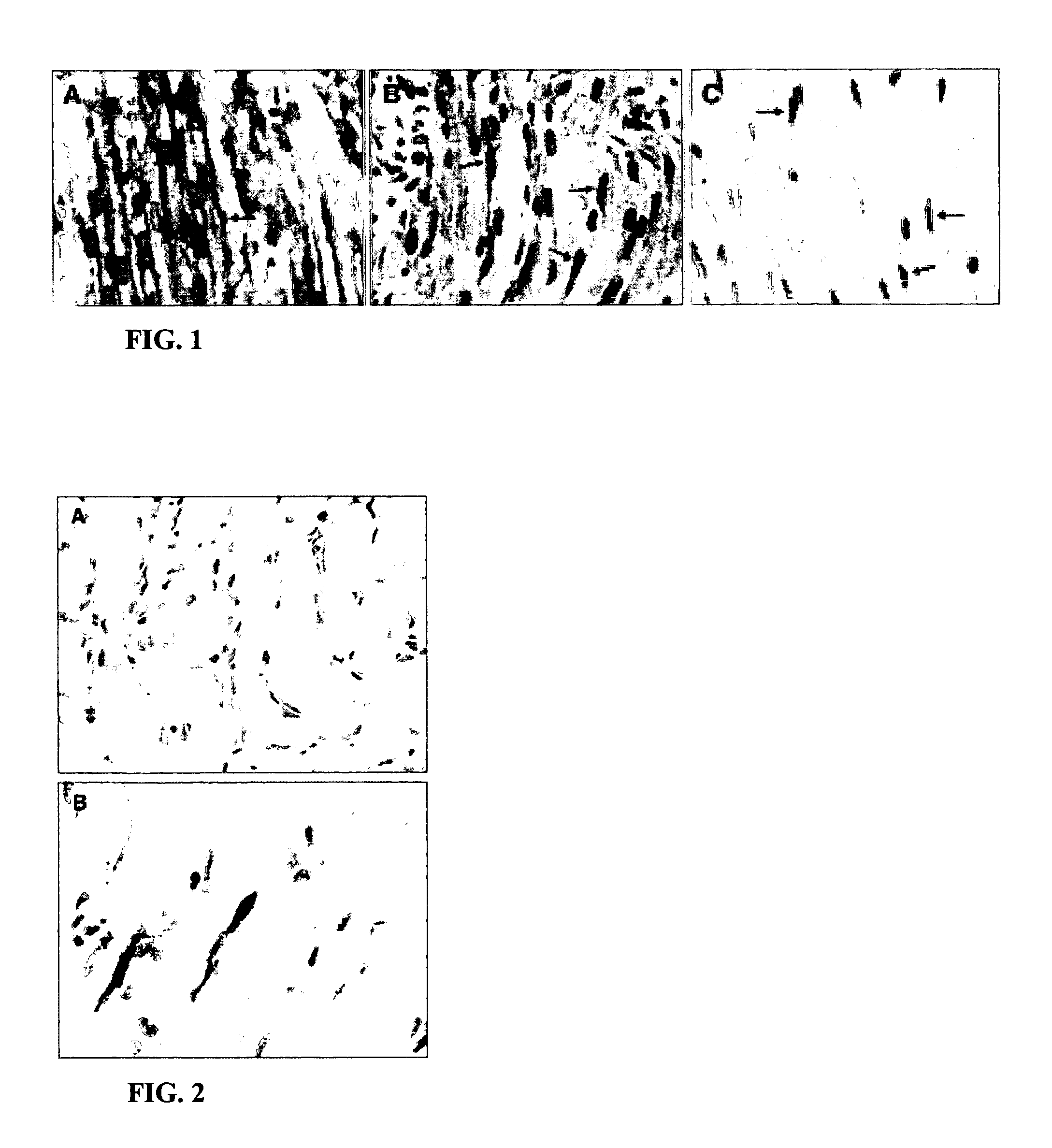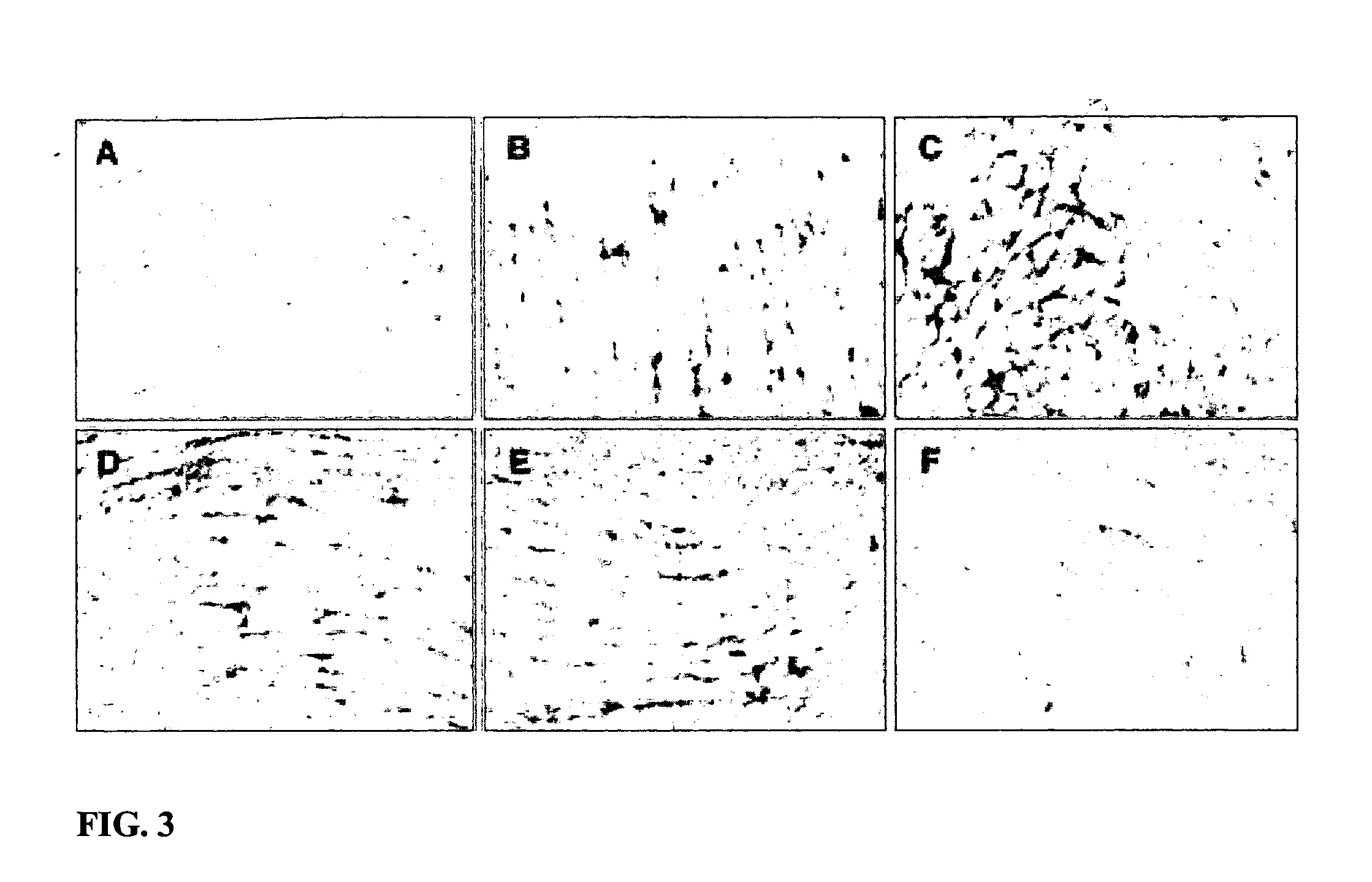Detection and isolation of cell populations from muscle using antibodies to fa1/dlk1
a technology of fa1 and cell populations, applied in the field of fa1 antibodies, can solve the problems of unpublished reports of fa1 expression in muscle stem- and progenitor cultures, and achieve the effect of enhancing differentiation into skeletal muscle cells
- Summary
- Abstract
- Description
- Claims
- Application Information
AI Technical Summary
Benefits of technology
Problems solved by technology
Method used
Image
Examples
example 1
FA1 / dlk1 in Human Fetal Muscle.
[0069] Human tissues: Normal fetal (n=6, gestational week 12-23) and neonatal (n=2, age=0 and 2 months) striated muscle tissue samples were obtained from the files at the Department of Pathology, Odense University Hospital. Formalin fixed and paraffin embedded human muscle specimens were cut in 5 μm sections, mounted on glass slides; air-dried and subsequently deparaffinized and re-hydrated. Endogenous peroxidase activity was blocked with H2O2 / methanol. Antigen-retrieval was performed by incubation with 0.05% (w / v) protease (Sigma, type XIV) in TBS at 37° for 15 minutes. Sections were incubated with a primary antibody (monospecific rabbit anti-human FA1) or a control antibody (primary antibody liquid-phase absorbed with affinity purified human FA1 as described in Jensen et al., 1993) diluted 1:100 (anti-human FA1) and subsequently reacted with a biotinylated secondary antibody (goat anti-rabbit IgG (DAKO E432, diluted 1:200)). The sections were then...
example 2
FA1 / dlk1 in Adult Human Striated Muscle.
[0072] Muscle tissue samples from 6 individuals with an inflammatory myopathy were obtained from the files at the Department of Pathology, Odense University Hospital. Normal adult skeletal muscle was obtained from biopsies with approval from the regional science ethical committee for Vejle and Funen counties.
[0073] Tissues were formalin-fixed and paraffin embedded and stained as in example 1. In normal adult human skeletal muscle no FA1 immuno-reaction was observed. By contrast, in a series of 6 inflammatory myopathies all characterized by containing inflammatory infiltrates and necrotic and regenerating muscle fibers, mononuclear FA1 positive cells were present. They were located in close relation to apparently intact muscle fibers but not found at sites of necrosis (FIG. 2).
example 3
FA1 / dlk1 Expression in a Rat Muscle Lesion Model.
[0074] Normal adult rat skeletal muscle was obtained from carbon monoxide (CO) intoxicated and decapitated Sprague-Dawley rats (M&B, Denmark). Animal experiment: Adult male rats (n=23) were deeply anaesthetized with pentobarbital and a knife cut lesion inflicted in the (thigh muscle). Animals were sacrificed by CO2-intoxication either 2 hours, 1, 3, 5, 7, 14, 32 or 56 days after the injury was inflicted and the lesioned muscle was removed. All rat specimens were quick-frozen in isopentane and stored at −70° C. until further analyzed. Cryosections (5 μm) of rat muscle specimens were air-dried overnight and fixed in acetone for 10 min at room temperature. Sections were incubated with a primary antibody (monospecific rabbit anti-rat FA1) or a control antibody (primary antibody liquid-phase absorbed with affinity purified rat FA1 as described in Jensen et al., 1993) diluted 1:2000 and subsequently reacted with a biotinylated secondary a...
PUM
| Property | Measurement | Unit |
|---|---|---|
| composition | aaaaa | aaaaa |
| affinity | aaaaa | aaaaa |
| plasticity | aaaaa | aaaaa |
Abstract
Description
Claims
Application Information
 Login to View More
Login to View More - R&D
- Intellectual Property
- Life Sciences
- Materials
- Tech Scout
- Unparalleled Data Quality
- Higher Quality Content
- 60% Fewer Hallucinations
Browse by: Latest US Patents, China's latest patents, Technical Efficacy Thesaurus, Application Domain, Technology Topic, Popular Technical Reports.
© 2025 PatSnap. All rights reserved.Legal|Privacy policy|Modern Slavery Act Transparency Statement|Sitemap|About US| Contact US: help@patsnap.com


